It's Thursday January 15, 2026
September 6, 2013
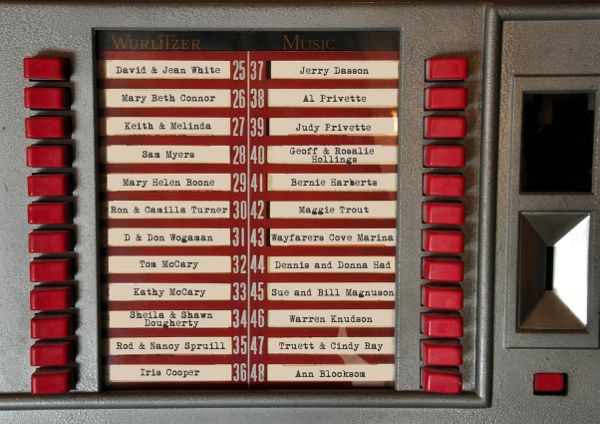 Many thanks to all who’ve contributed to fixing the Wurlitzer at the Oriental History Museum. The museum exceeded its goal of raising $500 — bringing in more than $750 in less than a week and a half. Three contributors delivered their donations in quarters, a fitting way to help to get the jukebox repaired. The museum has already sent off the amplifier for a refit. Thanks again to all…Many residents and visitors to Oriental hold memories of Red Lee’s 25¢ Hamburger (and Hot Dog) Grill. There was the sight of Red behind the counter, telling customers he would not in any way serve chili on a hot dog. And there were the smells of the 25 cent burgers on the grill.
Many thanks to all who’ve contributed to fixing the Wurlitzer at the Oriental History Museum. The museum exceeded its goal of raising $500 — bringing in more than $750 in less than a week and a half. Three contributors delivered their donations in quarters, a fitting way to help to get the jukebox repaired. The museum has already sent off the amplifier for a refit. Thanks again to all…Many residents and visitors to Oriental hold memories of Red Lee’s 25¢ Hamburger (and Hot Dog) Grill. There was the sight of Red behind the counter, telling customers he would not in any way serve chili on a hot dog. And there were the smells of the 25 cent burgers on the grill.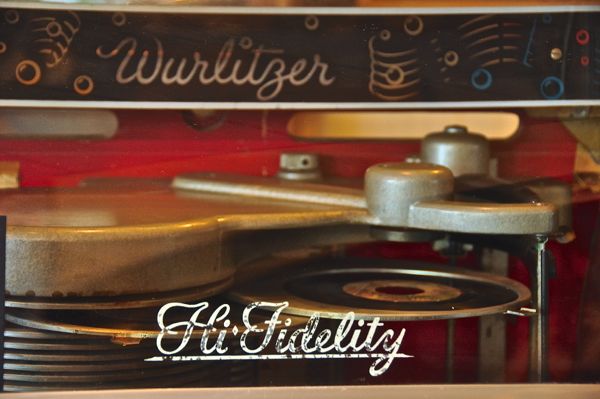 The top half of the jukebox from Red Lee’s grill. It’s a 1953 model and currently at Oriental’s History Museum. The Museum wants to get the jukebox working again. Your help is needed.
The top half of the jukebox from Red Lee’s grill. It’s a 1953 model and currently at Oriental’s History Museum. The Museum wants to get the jukebox working again. Your help is needed.There was something else, too. Oriental’s early iconic restaurant also had a signature sound and it came from the jukebox, a 1953 Wurlitzer, Model 1650A. It’s a sound unheard for many years now, but not because the jukebox is gone.
These days, the Wurlitzer is right across Broad Street at the Oriental History Museum. It just needs fixing, and the museum’s raising funds now so that Red Lee’s Wurlitzer can play once more.
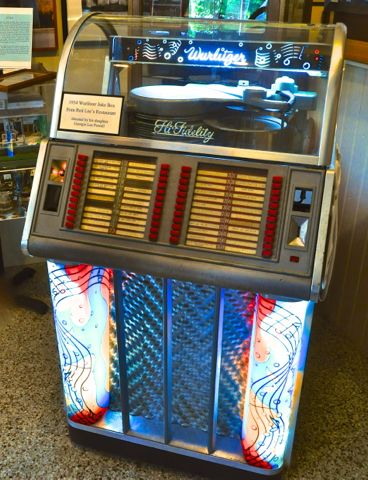 From the days when entertainment systems were large. The Wurlitzer lights up but doesn’t play. Repairs are needed.Red Lee’s Restaurant
From the days when entertainment systems were large. The Wurlitzer lights up but doesn’t play. Repairs are needed.Red Lee’s RestaurantRed Lee opened his roadside grill at Broad and North Streets in the 1940s. He ran it for half a century – keeping those burgers and dogs at a quarter apiece til the day he closed the restaurant in 1998. That inflation-defying price got him written up in the National Enquirer. Twice.
After Red passed away, his daughter, Georgie Powell – who still cuts hair at her salon next to the one-time grill – held on to the Wurlitzer and other things from her dad’s restaurant. Then, when Oriental’s History Museum opened 8 years ago, she donated that memorabilia.
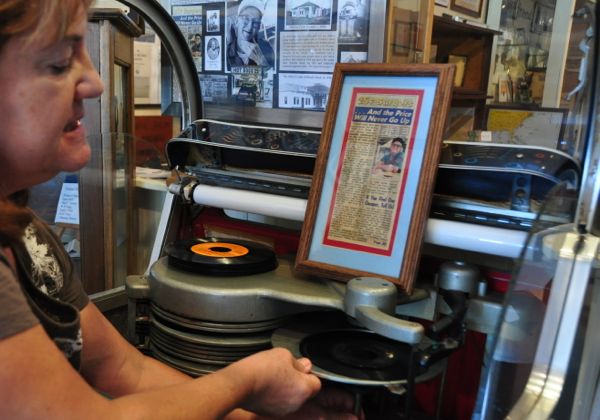 Remember when it took a needle to hear a song? Museum director Marsha Shirk manually shifts a platter with a 45 over to where it would be played. The museum’s raising funds now to get the Wurlitzer fixed so that it can operate automatically as it used to. (Sitting atop the record chamber, a framed article about Red Lee from the National Enquirer.)Wurlitzer A Reminder
Remember when it took a needle to hear a song? Museum director Marsha Shirk manually shifts a platter with a 45 over to where it would be played. The museum’s raising funds now to get the Wurlitzer fixed so that it can operate automatically as it used to. (Sitting atop the record chamber, a framed article about Red Lee from the National Enquirer.)Wurlitzer A ReminderThat is why today, long after the last twenty-five-cent burgers and hotdogs were served, you can go to the museum and see the roadside grill’s sign saying HOT DOGS 25¢ on one wall of the museum, while HAMBURGERS 25¢ is suspended from another. Nearby, is the Wurlitzer.
In an era of tapping in to all your music on a Cloud far, far away, or storing your tunes in devices that fit in your palm, the Oriental History Museum’s Wurlitzer stands as a stout, plus-sized XXXXXL reminder of what it used to take to hear a song.
To hear music used to mean feeding a coin in to the slot, pushing a button to select one of the dozens of songs listed – some hand-written, some typed. Vying for your attention might be “Monster Mash,” “Margaritaville,” “Lucille” or Joe Tex’s “Ain’t Gonna Bump No More With No Big Fat Woman.”
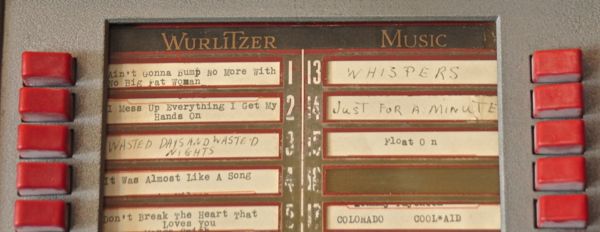 Part of the playlist of 48 songs you could hear on the Wurlitzer. Most of the 45s are still there.
Part of the playlist of 48 songs you could hear on the Wurlitzer. Most of the 45s are still there.You’d make your choices and then wait for the selected 45 to swing out from a stack and then wait for an arm with needle to move in to place to track through the 45’s grooves. The music would then come out of the speakers – behind a scrim of pressed aluminum at the base of the jukebox.
Some area residents who were teens in the 50’s remember dancing to the music that came out of the Wurlitzer. But it’s been years and years since the jukebox rocked a joint.
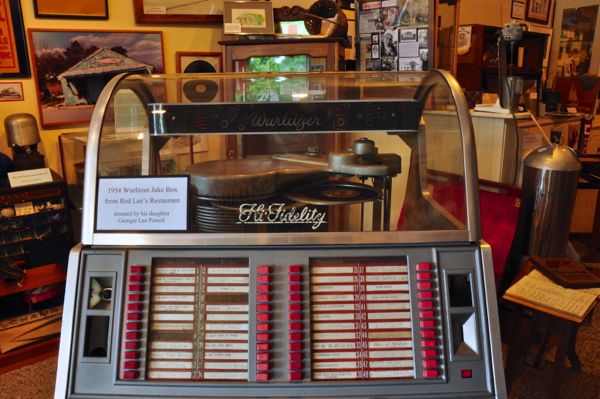 It has looks but right now, no voice.
It has looks but right now, no voice. The Wurlitzer 1650A which came out in 1953 used to play inside Red Lee’s hamburger and hot dog grill on Broad Street. The jukebox — and Red Lee’s signs — are now across the street at Oriental’s History Museum.
The Wurlitzer 1650A which came out in 1953 used to play inside Red Lee’s hamburger and hot dog grill on Broad Street. The jukebox — and Red Lee’s signs — are now across the street at Oriental’s History Museum.Many more photos .. and a way for you to help… just ahead.
[page]
Hearing The Wurlitzer AgainAs a museum piece, and based on just its looks, the Wurlitzer is a beauty to behold. The curved glass lid. The pressed aluminum of the speakers. The G-clef and musical note motif along the sides.
But something is missing.
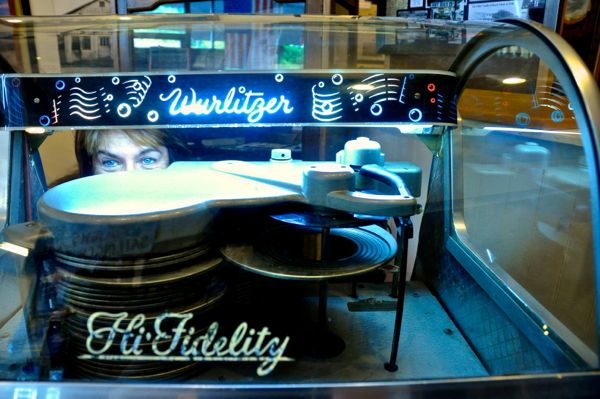 Oriental History Museum director Marsha Shirk surveys the interior of the Wurlitzer. Getting the Wurlitzer back up and running has been at the top of a wish-list of projects at the museum.
Oriental History Museum director Marsha Shirk surveys the interior of the Wurlitzer. Getting the Wurlitzer back up and running has been at the top of a wish-list of projects at the museum.The Oriental History Museum wants to bring the jukebox back to life so that visitors to the museum can appreciate the beauty of the Wurlitzer at its fullest. Museum director Marsha Shirk says the museum wants to get the jukebox fixed so that visitor can plug in a quarter and watch the mechanisms click, as a selected 45 slides over to be played and the hear a tune come from the speakers.
Needed: Repair And Funds To Pay For ItLou Ostendorf, a volunteer with the museum (and former president of its board) says the capacitor needs to be sent off to be repaired. After that, it’ll be possible to see if the machine’s mechanics and electrical system are in sync.
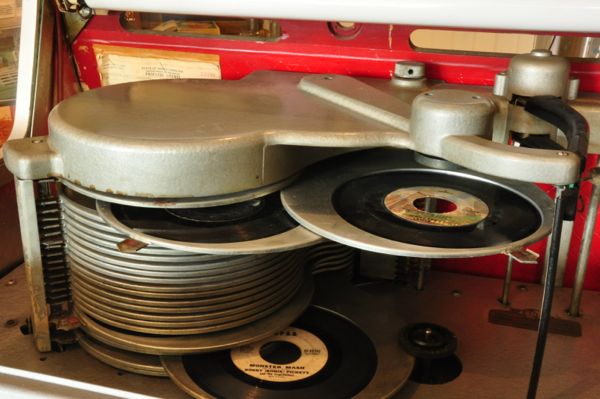 Oriental’s History Museum wants the Wurlitzer to be something more than an item to look at. The aim is to have those 45RPM records playing again.
Oriental’s History Museum wants the Wurlitzer to be something more than an item to look at. The aim is to have those 45RPM records playing again.That could take a lot of quarters. That initial capacitor repair will be about $200. And as Lou says, that’ll make it possible to diagnose what further repairs and part replacements are needed.
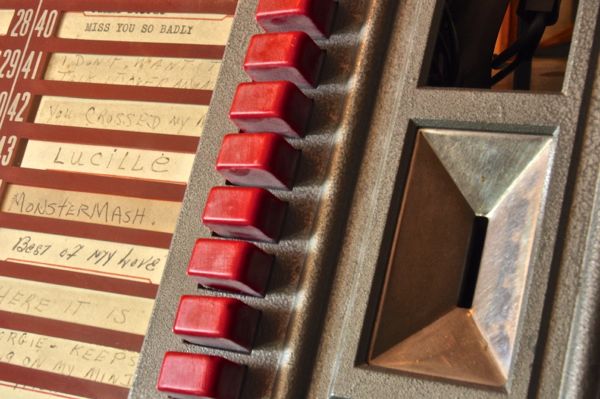 Coinage: Customers at Red Lees would plug nickels, dimes and quarters in to the Wurlitzer in order to play the selections. Now, the Oriental History Museum needs funds to restore the jukebox.
Coinage: Customers at Red Lees would plug nickels, dimes and quarters in to the Wurlitzer in order to play the selections. Now, the Oriental History Museum needs funds to restore the jukebox.That would be an expensive proposition for the Oriental History Museum which operates on a shoestring and relies on membership for its operating costs. (Unlike history museums in numerous other small towns funded by their town governments, the Oriental History Museum gets no funding from the Town of Oriental.)
Plug Some Quarters In The WurlitzerThis is where you can help. The Oriental History Museum is trying to raise funds – $500 – for the Wurlitzer restoration.
You can be part of the restoration effort. To give as many people as possible a chance to restore the Wurlitzer in this on-line fundraiser, contributions of up to one hundred quarters ($25) per person are welcomed. And the museum gratefully thanks you.
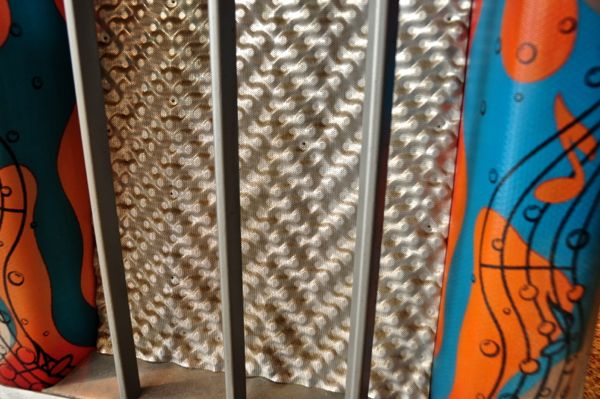 Almost half a century before earbuds, and iPod docks, the speaker of the Wurlitzer Model 1600 occupied the base of the jukebox.
Almost half a century before earbuds, and iPod docks, the speaker of the Wurlitzer Model 1600 occupied the base of the jukebox.Since the jukebox can’t accept quarters yet, a check for up to $25 may be sent to:
Friends Of Oriental’s History, PO Box 103 Oriental, NC 28571.(The Friends of Oriental’s History is a non-profit organization and contributions are tax deductible.)
When you send your check to the museum, send an email here to info@towndock.net as well. Names of Wurlitzer sponsors will be published on TownDock.net (unless you want to remain anonymous) as a thank you for helping to restore the jukebox.
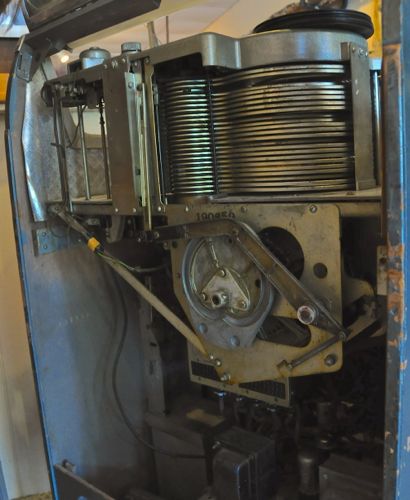 The interior of the Wurlitzer. Inside there are tubes and cutting edge technology.. of 1953.
The interior of the Wurlitzer. Inside there are tubes and cutting edge technology.. of 1953.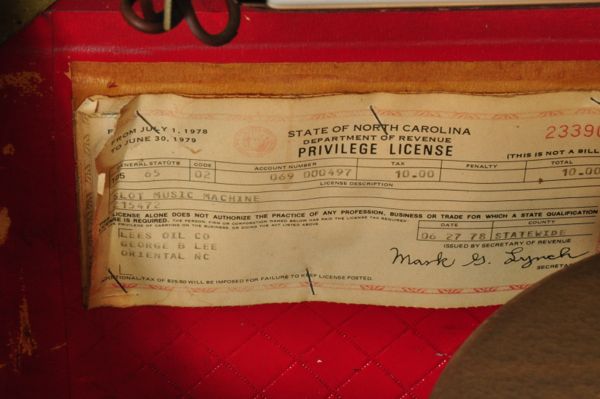 The State of North Carolina Privilege License, needed to operate a jukebox. Costing $10 and dating to 1979, it is taped just inside the record playing area.
The State of North Carolina Privilege License, needed to operate a jukebox. Costing $10 and dating to 1979, it is taped just inside the record playing area.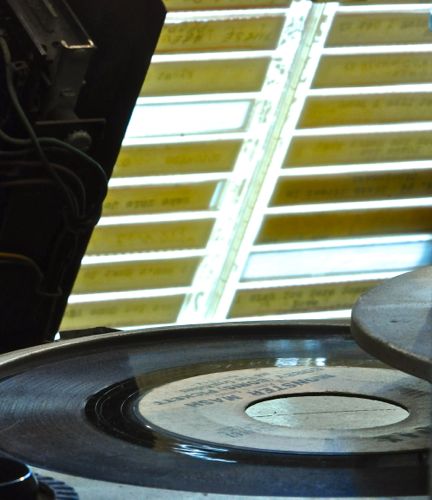 View from inside the jukebox. In background the labels listing each song, in foreground the 45 of the Monster Mash on a swing-out platter.
View from inside the jukebox. In background the labels listing each song, in foreground the 45 of the Monster Mash on a swing-out platter.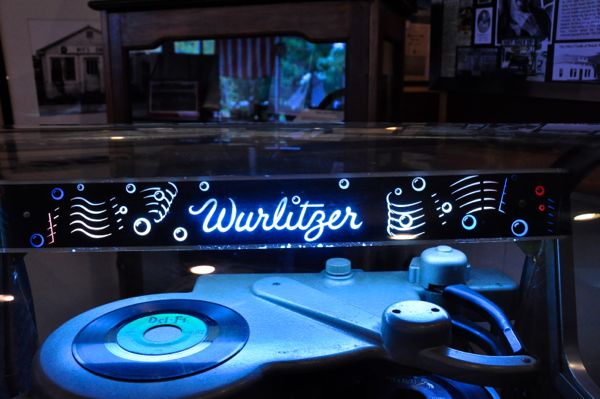 There is light. And once the repairs can be done, sound. It’s hoped that TownDock readers will contribute as they have in the past when it came to finding a storage home for the Oriental New Years Dragon.
There is light. And once the repairs can be done, sound. It’s hoped that TownDock readers will contribute as they have in the past when it came to finding a storage home for the Oriental New Years Dragon.